PULI, Taiwan—It’s Saturday afternoon in late January, and Pan Suchen is halfway through the day’s work. She’s got another hundred or more sheets to do before clocking off.
It’s not easy work, she explains between breaths as she reaches across the giant bed of hot iron, wiping her sweaty face with her forearm. She answers a question each time she moves past, flopping a wet piece of paper down on the iron press, then sweeping it over with the brush. The paper dries quickly, and there is steam everywhere. She peels it off, in the same move adding it to the dry bunch, then grabs another wet sheet with the long, thin, bamboo stick.
The basic idea is to get the stack of wet paper dry. This is done manually, one sheet at a time. Decades ago when she first started this work—or art, as it is now seen—every one of the movements she is doing now was fraught with peril. The paper could rip, buckle or scorch, and she frequently burnt her hands and elbows. The brush she uses weighs one kilogram, and its full weight can’t touch the paper. It took a whole year to be able to do it proficiently, and that was starting on small pieces.
Paper was invented by the Chinese close to two thousand years ago, and from there it spread to the rest of the world. Nowadays, the vast majority of paper is made by machines. This is what makes Suchen’s job, and the factory where she is doing it, so valuable. It was precisely this that Huang Huanchang and Wu Shuli, a husband and wife couple, wanted to get across when they opened the Kuanghsing Paper Factory (also spelt “Guangxing”) to the public in 1994. It was right after Huang finished his compulsory military service.
During the early 1990s most of Taiwan’s paper-makers moved their businesses to mainland China, where material and labour costs were cheaper. Precious few remained in Taiwan. Back then, paper-making was done by many smaller outfits. They simply set up along the side of the river, out in the open. When it flooded, they’d have to pack up shop for a while and wait it out. Conditions were tougher.
Apart from the general knowledge that the central province of Nantou is where paper is made, years ago the general public did not know much about the inner workings of one of the country’s most important cultural assets.
Puli is a special place in Taiwan; it is hidden amidst the mountains in the north of Nantou, the only landlocked province of Taiwan. Paper needs crystalline water, and Puli is the only place in the country to provide it. The overall soil content of the area contains few minerals, Wu explained, which means that the water is very clear, and perfect for what they need to do.
Wu took a few hours out of her hectic schedule to explain the history, motivations, and minute details of the fascinating operation she helps to oversee.
It’s not easy work, she explains between breaths as she reaches across the giant bed of hot iron, wiping her sweaty face with her forearm. She answers a question each time she moves past, flopping a wet piece of paper down on the iron press, then sweeping it over with the brush. The paper dries quickly, and there is steam everywhere. She peels it off, in the same move adding it to the dry bunch, then grabs another wet sheet with the long, thin, bamboo stick.
The basic idea is to get the stack of wet paper dry. This is done manually, one sheet at a time. Decades ago when she first started this work—or art, as it is now seen—every one of the movements she is doing now was fraught with peril. The paper could rip, buckle or scorch, and she frequently burnt her hands and elbows. The brush she uses weighs one kilogram, and its full weight can’t touch the paper. It took a whole year to be able to do it proficiently, and that was starting on small pieces.
Paper was invented by the Chinese close to two thousand years ago, and from there it spread to the rest of the world. Nowadays, the vast majority of paper is made by machines. This is what makes Suchen’s job, and the factory where she is doing it, so valuable. It was precisely this that Huang Huanchang and Wu Shuli, a husband and wife couple, wanted to get across when they opened the Kuanghsing Paper Factory (also spelt “Guangxing”) to the public in 1994. It was right after Huang finished his compulsory military service.
During the early 1990s most of Taiwan’s paper-makers moved their businesses to mainland China, where material and labour costs were cheaper. Precious few remained in Taiwan. Back then, paper-making was done by many smaller outfits. They simply set up along the side of the river, out in the open. When it flooded, they’d have to pack up shop for a while and wait it out. Conditions were tougher.
Apart from the general knowledge that the central province of Nantou is where paper is made, years ago the general public did not know much about the inner workings of one of the country’s most important cultural assets.
Bringing it to the public
Puli is a special place in Taiwan; it is hidden amidst the mountains in the north of Nantou, the only landlocked province of Taiwan. Paper needs crystalline water, and Puli is the only place in the country to provide it. The overall soil content of the area contains few minerals, Wu explained, which means that the water is very clear, and perfect for what they need to do.
Wu took a few hours out of her hectic schedule to explain the history, motivations, and minute details of the fascinating operation she helps to oversee.
The business had been in Huang’s family for several generations before they decided to make the changes. They had two guiding principles for continuing to operate the factory: one was to make sure that the tradition of hand paper-making in Taiwan did not die out, and the second was to introduce the delight of handmade paper to the younger generation and public in general. They instituted a raft of changes over the years that followed.
The most important was simply to open the factory up and let the public wander around. Tour groups stand to the side while masters like Suchen work at their craft. The factory also began to rely on the income from its buzzing souvenir store as much as the paper it sells.
They also began consulting universities from around the country, beginning an exchange that would educate both parties. They were interested in recycling, protecting the environment, and using alternative materials for paper. They began working with unprecedented materials, breaking away from the tradition of just using trees.
Wu said, for example: “R&D [research and development] found out that water bamboo could be turned into calligraphy paper. We called it ‘Fortune Paper,’ because here in Puli there is a massive quantity of this water bamboo. The husks are discarded in really large quantities, so we started to grab them and use them for paper. In the end, we found out that it actually works excellently.”
Some of other products they experimented with include banana skins, and discarded husks of sugar cane. Both of these were also convenient to get a hold of and were otherwise being wasted.
Another change they made was to elevate the status of the workers in their factory. Instead of regarding the job as simple manual labour, they were addressed as “masters,” given uniforms, and named on a giant display in the foyer with professional photos blown up twice the size of life.
The work is tough and takes a long time to learn. In summer, for example, no fans are allowed, because the breeze would create problems with the drying. Winter brings its own share of troubles, too, as the old joints and tendons get stiff. Suchen knows a lot of people who tried the job for a while but found it was too much and went back to the farm. Apparently it’s easier to work the rice fields than the paper stacks.
The central importance of the human touch, however, is something that Huang and Wu were determined to get across. “At the start we faced the issue of the factory closing, people were skipping to better jobs, the industry was moving abroad, and Taiwan’s competitiveness was really nothing, because of the price issues,” she said.
“Before, papermakers had the attitude that they were just coming to work, and they didn’t really see the importance or value of their work… we had to elevate the value of paper, elevate the value of master papermakers, to build an image for the profession,” she explained.
Machine paper is made on a continuous roll, and there is a clear grain to it. Try ripping a page of a newspaper and you’ll see; it rips fine one way, but badly the other. The handmade paper produced by Kuanghsing rips badly any way, because it has no grain. This lack of grain is what makes it ideal for Chinese calligraphy and painting, as the ink has no way to run—it’s contained only to where the brush touches. Such paper can also only be made by humans, because the no-grain feature is predicated on imperfection and randomness. Machines can make exactly the same movements a million times in a row, but humans’ are just not the same.
“The thing about handmade paper is that when people make it, they move, and the fibres intermingle. It’s irregular, in a sense, and it has life. Every piece is different; handmade is softer. Machine made paper is dull, mechanical, and rigid.” But of course, there’s always a cost to quality, Wu said. “What’s the problem with handmade paper? There’s no way to achieve real quantity.”
Their many efforts have been recognised by the government, and this has also been an essential step in their development; it was the Cultural Affairs Office which provided guidance throughout the process. It was through this that people were able to start to realise the importance of what they were doing, she explained.
The paper-making process
The first step to making the paper is to collect the plant fibres. They are mixed with a dose of water and then smashed into an unrecognisable white pulp. The pulp is then mixed with more water until it reaches the right consistency, which can only be judged by an experienced master. The transparency of the final product depends on the water-to-fibre ratio.
Next, the pulp is put into troughs. From the trough the pulp is scooped up into a semi-permeable board, excess water sloughs off, and what’s left over is the first step in a piece of paper. The boards at Kuanghsing are made from a series of thin pieces of bamboo all bound together, something like the boards used to roll sushi. They are then clamped inside a wooden frame, which stops the pulp from running off to the sides.
The bamboo board holding the paper pulp then gets unhooked from the frame, and the whole thing is swung and dropped, upside down, onto the bench to the side. One at a time, the pieces, which are still sopping wet and have not had a chance to form properly, are placed on top of one another.
At this point the work is still quite weak and wet, and if someone accidently fell onto a stack, it would probably feel something like mashed potatoes—the paper doesn’t feel like parchment yet. The reason they don’t all stick together when left in a stack goes back to that vital human element: there is no grain in any of the pieces, the fibres in the pulp making up each sheet are scrambled, so each layer keeps to itself and can’t form bonds with the sheet above or below.
This point is well proven in the next step, because once a few thousand are all stacked up they get wheeled away for heavy-duty pressurisation. The whole stack is put under a machine and squeezed to get rid of excess water, then delivered to Suchen and her colleagues, who dry them out for the waiting public.
Originally, Suchen only started working at the Kuanghsing Paper Factory because she lived nearby, had just graduated from high-school, and needed a job. Things are easier for today’s kids, and despite all the efforts of people like Huang Huanchang, Wu Shuli and Pan Suchen, the average worker at Kuanghsing is still above middle age. They keep at it, however, and in the process keep papermaking—and its partner, calligraphy—relevant for the current generation.
The students who come to the factory for a taste of the life of a papermaker also get to keep their creations. Engaging young people was, after all, a central theme for the founders of the open plan.
Visit the website of the Kuanghsing Paper Factory.
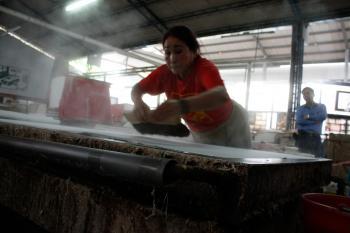

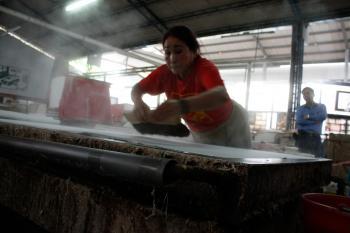
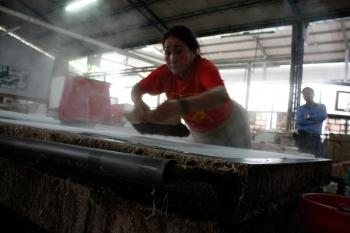
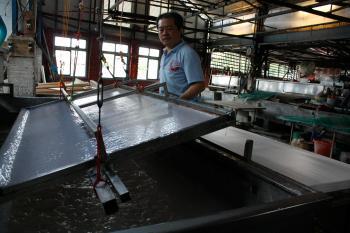
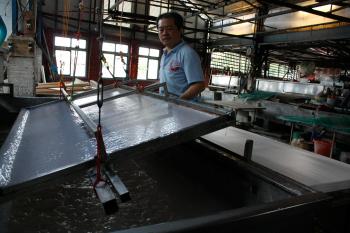
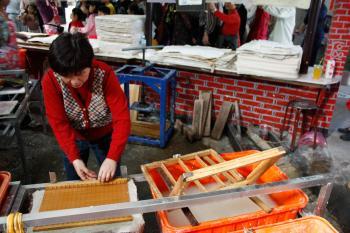
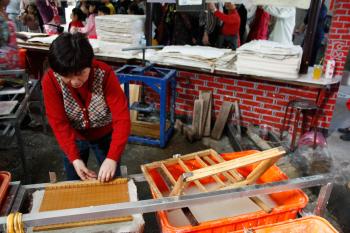
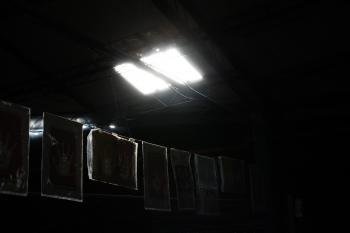
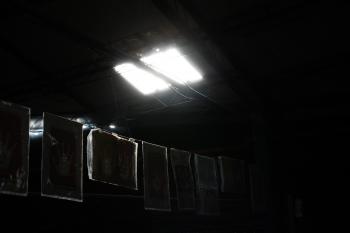
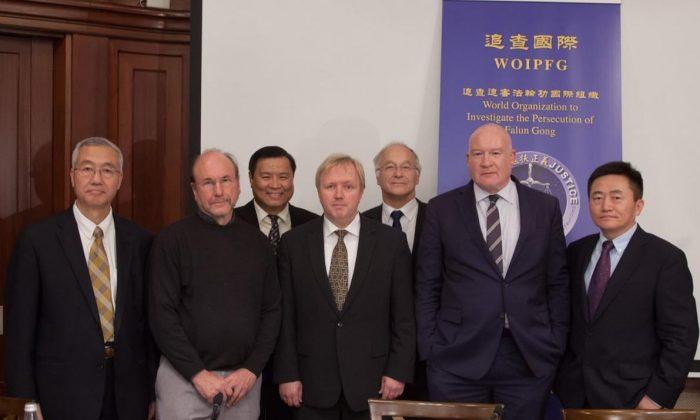
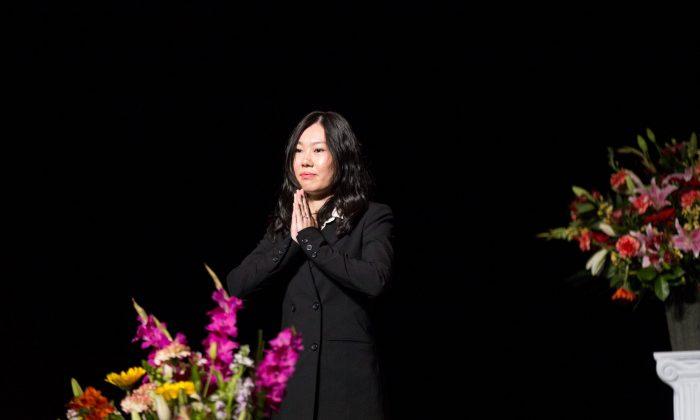
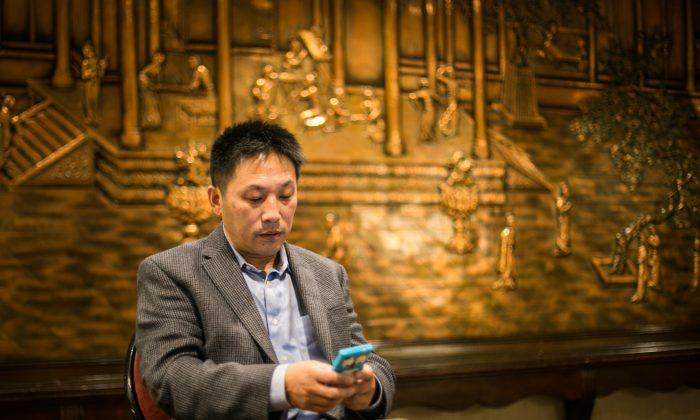

Friends Read Free